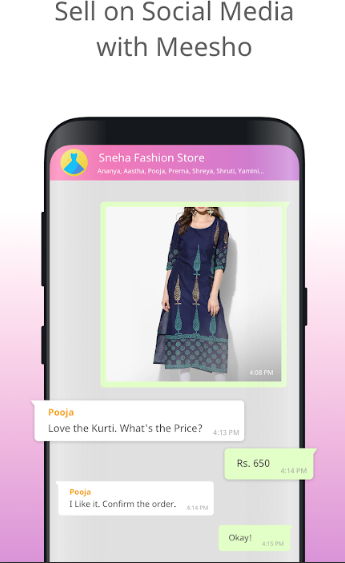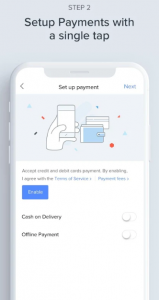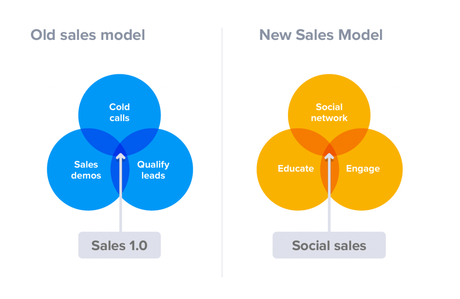Humans are hardwired to seek approval and advice from those around us. It is no different when it comes to the way we buy and sell.
The only difference is that now we have resources to capitalize on this social element, making us smarter and more intuitive in our approach.
What Is Social Selling?
It is the art of using social media to find, connect with, understand, and nurture sales prospects.
It’s a modern way of developing meaningful relationships with potential customers so you’re the first person a prospect thinks of when they’re ready to buy.
Social selling makes use of upcoming social media technologies to sift through the thousands of prospective targets by filtering out unnecessary data and targeting new customers.
Social selling transforms your sales team members from being mere sales reps into trusted partners by your targeted customers.
Social Selling – Uplifting Statistics
There is a 2x higher ROI from social selling than email marketing, cold-calling, networking or trade shows
78.6% of sales reps who used social selling outperformed their peers
75% of customers use social media as part of the buying process
46% of social sellers fulfilled their quota compared to 38% of sales reps who didn’t
Companies with consistent social selling processes are 40% more likely to hit revenue goals than non-social sellers.
31% of B2B professionals said that social selling allowed them to build deeper relationships with their clients.
Source : http://biznology.com/2014/12/37-facts-future-social-selling-vs-cold-calling/ and Forbes.com
Suggested read | Dummies Guide To A Successful E-Commerce Store
Components Of Social Selling
Traditionally sales team will often track down prospective clients, without really getting insights first of what their prospects really want and if they have an inclination to avail your products. Social selling does this in reverse.
3 points are key to effectively connect with targeted prospects and eventually convert them into sales.
1. Listen

Listen to what the customer wants, the issues they are focused on, and the needs they may have now or in the future. You can gain an insight of what is important for them and how you can relate your brand.
2. Engage
 Engagement by liking, sharing, re-tweeting of your posts. These activities will gain the attention of your targeted prospect.
Engagement by liking, sharing, re-tweeting of your posts. These activities will gain the attention of your targeted prospect.
The second step : Create content that that relates to the needs or interests of your prospects.This can be learnt from their profiles.
Use keywords and hashtags that your prospects are using, and expound on a topic they have already posted and are interested in.
3. Connect
 This is where direct engagement comes in. Commenting, liking or sharing your content is a signal you can directly connect with them in an unobtrusive way. From there you can develop a stronger relationship that will eventually make them interested in your products.
This is where direct engagement comes in. Commenting, liking or sharing your content is a signal you can directly connect with them in an unobtrusive way. From there you can develop a stronger relationship that will eventually make them interested in your products.
Also Read | 4 powerful ways Instagram will be a game changer for E-commerce 2019
How Social Selling Improves Productivity And Profitability

1. Lead Generation
Important measure of success for digital marketing, but social selling takes this one step further as it provides insight on who your targeted leads are and the perfect timing you can take when engaging with these leads.
2. Lead Qualification
Identifying your leads does not necessarily result into an eventual sale. Social selling can help you qualify your leads and identify those who have greater than average probability of availing your products and services.
3. Prospects/Client Management
Sometimes the timing is not right to engage with prospects or even with existing customers. Social selling will provide you with the intelligence and the insights you need to gauge if the time is right to take action as well as the type of action your sales team should take to get results.
Social Selling Apps That Are Killing It!
Meesho
Meesho found its potential social sellers in housewives, entrepreneurs, students, teachers. who promoted their online businesses using WhatsApp, Facebook etc.
It has enabled over 20,00,000 social sellers in more than 500 towns and created a market that was not there before.
Meesho allows sellers to manage purchases and process payments, as well as a network of wholesale suppliers and logistics providers.
It offers everything its vendors need to start selling online. This leaves vendors responsible for customer acquisition, picking what items they want to include in their online shops and marketing them.
This reselling model appeals to small stores and individuals, who want to make money, but don’t want the expense of setting up a business from scratch and carry inventory.

GlowRoad
 It helps women earn from home by reselling a variety of trendy products such as clothing, home furnishing, jewelry etc in their social network. You can start a flexible home business at zero investment in a secure way.
It helps women earn from home by reselling a variety of trendy products such as clothing, home furnishing, jewelry etc in their social network. You can start a flexible home business at zero investment in a secure way.
Resellers have direct access to suppliers who provide high quality products at really low prices.
No investment and no stock purchase needed. Users can make their own online shop on GlowRoad simply by copying products from suppliers.
When someone makes a purchase, they earn the margin as set by them. The supplier ships the product directly to the customer’s address.
The company claims to reach more than 100K resellers, over 20K suppliers and more than 300K buyers. It has grown from 15-20 transactions per day last year to 15K transactions every day.
Zepo
Zepo makes online selling simple & easy. Using Zepo, one can open their online store in under 5 minutes. Zepo’s Complete E-Commerce Solution clients achieve anywhere between 2 – 30 times the return on investment.

One of the greatest sources of customer acquisition for us has been word-of-mouth & referrals. They launched the Partner Program for Web Developers, Bloggers, e-Commerce Consultants and Students; wherein upto 30% of revenue is shared with the partners.
Kartrocket
 Kartrocket offers free payment gateway integration, a mobile app to manage a store, and logistics services through its ShipRocket platform. The firm also supports multiple marketplace integrations, enabling brands to sell on other e-commerce platforms.
Kartrocket offers free payment gateway integration, a mobile app to manage a store, and logistics services through its ShipRocket platform. The firm also supports multiple marketplace integrations, enabling brands to sell on other e-commerce platforms.
Kartrocket also operates a consumer-to-consumer e-commerce marketplace called Kraftly, which enables any offline or online seller to create a storefront and start selling on its platform.

The marketplace sells products from categories such as art, apparel, fashion accessories, food, beauty products, toys among others.
Shopmatic
 Shopmatic has always been focused on enabling a successful ecommerce business for its customers. It has eliminated the barriers by taking away the hurdles of price and device accessibility. By leveraging the smartphone penetration and coupling it with pricing flexibility, it intends to bring 500,000 customers into the ecommerce ecosystem in the coming year.
Shopmatic has always been focused on enabling a successful ecommerce business for its customers. It has eliminated the barriers by taking away the hurdles of price and device accessibility. By leveraging the smartphone penetration and coupling it with pricing flexibility, it intends to bring 500,000 customers into the ecommerce ecosystem in the coming year.
Shopmatic believes that SMEs and aspiring entrepreneurs should have the freedom to make use of a comprehensive platform without the burden of an upfront investment or committed fees.


It is therefore making its platform available at the cost of only Rs 50 for one year. Customers set up their online store and pay 3% when they make a successful sale.


It has already helped over 50,000 sellers establish a thriving online business by offering an entire ecosystem to sell online at their disposal.
Conclusion
It’s time to move on from traditional, ineffective sales tactics by transforming sales processes. Embracing social selling will help you meet quotas, elevate your core performers, increase your pipeline and revenue, and maximize your profitability.





